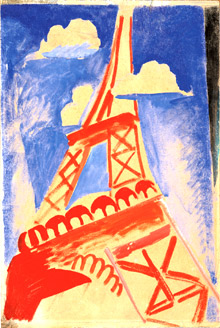
Pablo PICASSO Femme au chapeau dans un fauteuil (Womand with a hat in armchair). Oil on canvas, 1939, 65x54 cm, © ADAGP, Paris
|
|
ESPACE D’ART CONTEMPORAIN FERNET BRANCA
2, rue du Ballon
68300 SAINT-LOUIS (Alsace)
INFORMATION:
Tel: +33 (0)3 89 69 10 77
Site : www.museefernetbranca.fr
musee-fernet-branca@wanadoo.fr
OPENING HOURS:
From Wednesday to Sunday, from 2:00 to 7:00 PM. Closed on Mondays and Tuesdays
ADMISSION PRICE:
Full rate: 6€. Reduced rate: 5€.
CURATOR:
Florian Rodari, Curator of the Fondation Jean et Suzanne Planque
PRESS CONTACT:
Auguste Vonville. Tel: +33 (0)3 89 69 10 77 (set line) or +33 (0)6 08 58 74 43 (cell phone)
E-mail:vonville.auguste@wanadoo.fr

|
The Espace d’Art Contemporain Fernet Branca invites us on a very special artistic journey. The idea is to step right into an extraordinary collection in which the works of art weave subtle links with one another. The collection is the result of a passion, of curiosity and of a perceptive look on modern painting, brought together by Jean Planque (1910-1998).
Remarkable coherence
In the 40s Jean Planque bought for himself or for friends, a few paintings by great masters of the XIXth and XXth centuries. This was the beginning of a long quest which neither his education nor his studies had predisposed him to. This fortuitous encounter with art led him to collect masterpieces by Picasso, Klee, Dubuffet or de Staël. The specific character of this collection is not only due to the fact that it is made up of works by the most important artists of the century, but above all it reveals a rare coherence between the pieces conserved. It is the fruit of an enthusiastic eye on modern painting; an eye that wished to understand an art that tried for numerous decades to change the way people looked, to break the standards set by tradition; it is in some sorts a perceptive eye, the one of an amateur who confided he had a passion, that «burnt for the paintings. »
The eye for Beyeler
Once Jean Planque was remarked by gallery owners for his instinct to recognize a real work among the run-of-the-mill productions, he became the courtier for Beyeler, and bought for him in Paris. He did not choose unknown painters but rather those already famous. His curiosity and his enthusiasm allowed him to approach the greatest artists of his time, in particular Picasso, Giacometti and Dubuffet, who treated him as an equal. From Cézanne to Picasso, from Degas to Bonnard, from Van Gogh to Rouault, Dubuffet and Kosta Alex, he was lead by one single concern: he would make no concessions to imagery nor to prettiness; on the contrary, he solely pursued efficiency, depth and the solitude of the pictorial language. Behind each painting in the collection there is a story, an anecdote. When one covers the whole itinerary, one is struck by the sort of tension between the first place granted to Dubuffet and, in a certain way, to Picasso and then the more intimate choices that go from Bonnard to Nicolas de Staël.
 Robert DELAUNAY Tour Eiffel Gouache on cardboard, 1928, 50,4x 33,8 cm © L&M services B.V. Amsterdam 20020842
The exhibition is organized in collaboration with the Fondation Jean et Suzanne Planque. Jean Planque himself, with his friends, created it in 1997 with the aim of protecting the paintings he had collected, and to ensure them a venue in coherence with the spirit that presided over their being brought together and to have that richness be known through exhibitions and publications. The collection includes some 130 paintings and works on paper by 50 different artists, and has a rare coherence. It reflects this man’s double demand, he who was also a painter. On the one side it translates his respect for the rigorous construction of a painting (Cézanne and his heirs, the Cubists such as Gris, Braque, Léger, Delaunay), for the poets of form (such as Klee and Bissière). On the other side, it marks his deep attachment for earthly values (Rouault, Tapiès, de Staël) or his irresistible attraction towards the inventive liberty of a Dubuffet whose confident he was for a long time, but also of his Vaudois friends Auberjonois, Soutter or even Aloïse.
To see more illustrations, click on VERSION FRANCAISE at the top
of this page
|



